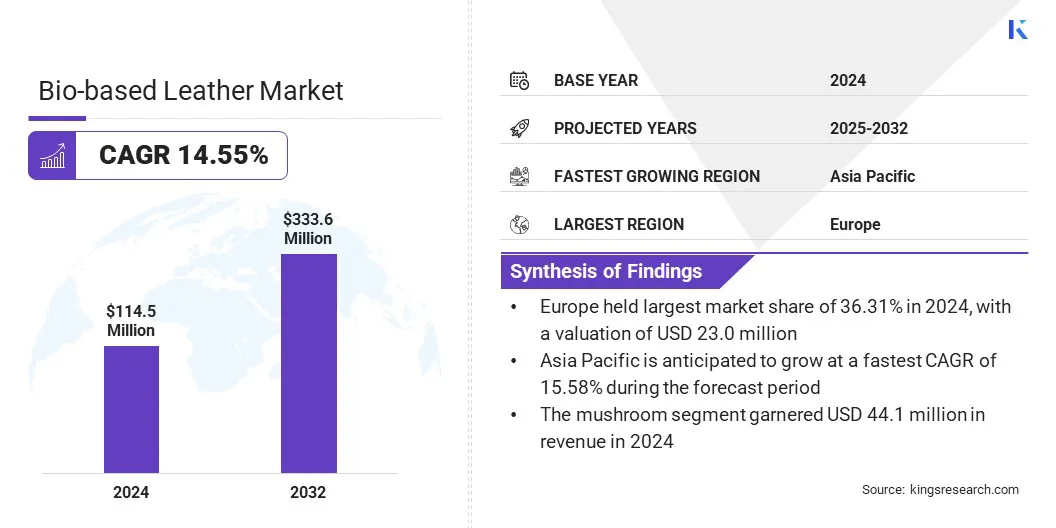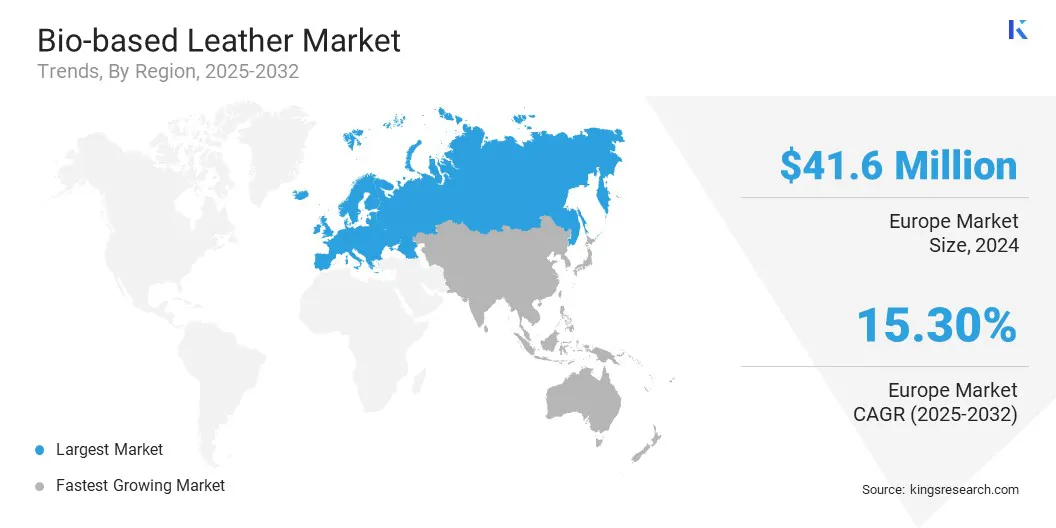Market Definition
Bio-based leather is a sustainable alternative to traditional animal-derived materials produced using plant fibers, fungal mycelium, or recycled biopolymers. It offers comparable durability and an aesthetic appeal while reducing environmental impact and chemical use.
The market includes fashion, upholstery, automotive interiors, and accessories where eco-friendly materials are increasingly in demand. Brands manufacturers integrate bio-based leather into sneakers, furniture, car seats, and handbags to meet the rising consumer demand for cruelty-free products and lower carbon footprints.
The global bio-based leather market size was valued at USD 114.5 million in 2024 and is projected to grow from USD 128.9 million in 2025 to USD 333.6 million by 2032, exhibiting a CAGR of 14.55% during the forecast period.
The market is driven by the rising demand in the fashion, automotive, and furniture sectors seeking sustainable and cruelty-free alternatives. Additionally, innovations such as bio-finishing with natural peptides are improving material durability and aesthetics without harmful chemicals, making bio-leather suitable for high-performance, eco-conscious product applications.
Key Highlights
- The bio-based leather industry size was valued at USD 114.5 million in 2024.
- The market is projected to grow at a CAGR of 14.55% from 2025 to 2032.
- Europe held a market share of 36.31% in 2024, with a valuation of USD 41.6 million.
- The mushroom segment garnered USD 44.1 million in revenue in 2024.
- The footwear segment is expected to reach USD 124.8 million by 2032.
- Asia Pacific is anticipated to grow at a CAGR of 15.58% during the forecast period.
Major companies operating in the bio-based leather market are Ananas Anam Ltd., Bolt Threads, Natural Fiber Welding, Inc., Modern Meadow, MycoWorks, Ecovative LLC., Vegea SRL, Fruitleather Rotterdam, Ultrafabrics Holdings Co., Ltd., Desserto, ECCO Leather B.V., VEGATEX BIOTECH (HK) LTD., Modern Synthesis, Evoco Ltd., and Beyond Leather Materials.

Bio-based Leather Market Report Snapshot
|
Segmentation
|
Details
|
|
By Source
|
Pineapple, Mushroom, Leftover Fruits, Others
|
|
By End-use Industry
|
Footwear, Garments & Accessories, Automotive, Furniture & Furnishings, Others
|
|
By Region
|
North America: U.S., Canada, Mexico
|
|
Europe: France, UK, Spain, Germany, Italy, Russia, Rest of Europe
|
|
Asia-Pacific: China, Japan, India, Australia, ASEAN, South Korea, Rest of Asia-Pacific
|
|
Middle East & Africa: Turkey, U.A.E., Saudi Arabia, South Africa, Rest of Middle East & Africa
|
|
South America: Brazil, Argentina, Rest of South America
|
Bio-based Leather Market Regional Analysis
Based on region, the market is classified into North America, Europe, Asia Pacific, Middle East & Africa, and South America.
The Europe bio-based leather market share stood at 36.31% in 2024, with a valuation of USD 41.6 million. This dominance is driven by the active adoption of sustainable materials by leading luxury fashion houses across France and Italy.
These brands are incorporating bio-based leather alternatives into their high-end products through partnerships with innovative material startups. This approach is generating a strong demand in the premium segment, which reinforces the potential of bio-based leather within the fashion industry’s most influential tier.
- In January 2024, Kering Ventures invested in SQIM, an Italian biomaterials startup, through a USD 12.90 million Series A funding round. The investment focuses on mushroom-derived leather alternatives, which produce materials through industrial-scale fermentation. The company plans to build a demo plant to expand production capacity and support luxury brands like Balenciaga.

The bio-based leather industry in Asia Pacific is poised for a CAGR of 15.58% over the forecast period. This growth is driven by the presence of some of the world’s largest original equipment manufacturers (OEMs) in the fashion, automotive, and consumer goods sectors across Asia Pacific.
These manufacturers face growing pressure from global brands to meet sustainability standards. In response, many suppliers are transitioning to bio-based leather to maintain business relationships and access premium supply chains. This transition is expanding production capacity and strengthening regional expertise in sustainable material development.
- In March 2025, Dessel unveiled its bio-based leather series called BIO, along with GO‑TAN organic tanning and BP-FREE bisphenol-free technologies at the Asia-Pacific Leather Fair (APLF) in Hong Kong. These solutions include automotive upholstery-grade materials designed to meet global brand sustainability standards and reduce chemical content.
Bio-based Leather Market Overview
Rising consumer preference for sustainable and cruelty-free materials is driving the adoption of bio-based leather as an alternative to traditional animal leather. Growing awareness of the environmental impact associated with leather production, including water usage, chemical processing, and greenhouse gas emissions is prompting a shift toward eco-conscious choices.
Plant and fungus-based leathers made from pineapple leaves, mushrooms, and cactus are becoming popular in the fashion, automotive, and accessories industries. These materials offer aesthetic and functional qualities while significantly reducing environmental harm. Brands are incorporating bio-based leather to align with ethical sourcing and circular economy goals.
- In October 2024, TomTex launched its100% bio-based biodegradable mushroom-and-shrimp shell leather, offering a fully natural alternative for fashion and accessory products. The material achieves cost parity at approximately USD 2.50–3.50 per square foot, making it competitive with mid-tier animal leather.
Market Driver
Growth in Fashion, Automotive, and Furniture Applications
The expanding use of bio-based leather in fashion, automotive, and furniture applications is driving steady growth in the market. Footwear, bags, and accessories are increasingly incorporating plant- and fungus-based leather to meet consumer demand for sustainable alternatives. Automotive manufacturers are using bio-based leather in car interiors to reduce the environmental impact and align with eco-friendly vehicle initiatives.
Moreover, furniture brands are adopting these materials for upholstery and combining durability with ethical sourcing. Companies across these sectors are using bio-based leather to support sustainability targets and enhance brand image.
- In November 2024, Pangea introduced Pulvera and Verita, two advanced leather materials designed specifically for automotive interiors. They are nearly 90% bio-based and use recycled processing methods to reduce landfill waste and chemicals in tanning. Pulvera employs recycled agent technology to minimize chemical usage by over 30%, while Verita offers a compostable and metal-free tanning process, supporting vehicle sustainability initiatives.
Market Challenge
Higher Production Costs Compared to Conventional Leather Limiting Competitiveness
A key challenge in the bio-based leather market is the higher cost of production driven by advanced manufacturing processes, sustainable raw material sourcing, and limited economies of scale. These factors make bio-based leather significantly more expensive than conventional animal leather or synthetic alternatives like polyurethane. This price gap makes it difficult for manufacturers to position bio-based leather competitively in mainstream applications.
To address this challenge, market players are optimizing production techniques, expanding pilot-to-commercial scale operations, and securing strategic partnerships to lower material and processing costs. Additionally, companies are targeting premium and sustainability-focused segments to stimulate demand, enhance brand positioning, and achieve long-term cost reductions through economies of scale.
Market Trend
Bio‑Finishing with Natural Peptides
A key trend in the bio-based leather market is the use of natural peptide-based finishes to improve product performance and environmental safety. Solutions like Evolved by Nature’s Activated Silk peptide finish are being developed to enhance durability without relying on traditional synthetic coatings. These innovations are reducing the need for harsh chemicals in the finishing process, aligning with cleaner production practices.
The application of bio-finishing is making bio-based leather more suitable for high-wear uses while maintaining its eco-friendly profile. Manufacturers are adopting these methods to meet performance expectations and sustainability goals.
- In November 2024, Evolved By Nature partnered with six members of Authentic Thai Leather, including tanneries like Chun Wang Brothers and Kongsiri Tannery, to implement their Activated Silk L1 biofinishing system at a commercial scale. This peptide-based finish uses natural silk-derived Activated Silk molecules to coat leather without PFAS or added cross-linkers.
Market Segmentation
- By Source (Pineapple, Mushroom, Leftover Fruits, and Others): The mushroom segment earned USD 44.1 million in 2024, due to its scalable production, strong mechanical properties, and increasing adoption by major fashion and automotive brands seeking high-performance, sustainable alternatives.
- By End-use Industry (Footwear, Garments & Accessories, Automotive, Furniture & Furnishings, and Others): The footwear segment held 35.87% of the market in 2024, owing to high-volume demand from global shoe brands seeking sustainable materials to meet consumer expectations and environmental regulations, while maintaining design and performance standards.
Regulatory Frameworks
- In the U.S., the United States Department of Agriculture (USDA) BioPreferred Program offers procurement preference to certified bio-based materials, encouraging adoption across federal agencies. Additionally, California’s Safer Consumer Products (SCP) Program restricts harmful chemicals like phthalates and PFAS, promoting safer alternatives such as bio-based leather.
- The European Union (EU) Deforestation Regulation (EUDR) mandates traceability for leather-related imports, while REACH (Registration, Evaluation, Authorisation and Restriction of Chemicals) restricts hazardous substances like chromium VI. Additionally, the Ecodesign for Sustainable Products Regulation (ESPR) and the EU Ecolabel program promote durability, recyclability, and environmentally responsible sourcing.
- China’s new GB/T 44838-2024 standard, effective from June 2025, sets the criteria for “green” leather, including waste management, energy use, and greenhouse gas tracking. The Eco-Leather Mark, issued by the China Leather Industry Association, requires ISO 9001/14001 certification and third-party audits.
Competitive Landscape
Major players in the bio-based leather industry are adopting strategic partnerships, advanced material R&D, and application-specific customization to stay competitive in the market. Companies are increasingly working with leading automotive and fashion brands to co-develop materials that meet performance and sustainability standards.
There is a growing focus on adapting bio-based leather for demanding use cases such as car interiors, by combining plant-based proteins and recycled polymers. These efforts are helping improve material quality and scalability, while strengthening the commercial viability of bio-based leather across industries.
- In June 2025, Modern Meadow partnered with Mercedes‑Benz AG to adapt its INNOVERA bio-design leather alternative for the CONCEPT AMG GT XX model. This material combines plant-based proteins and recycled racing car tire polymers. The partnership focuses on feasibility for series production in automotive interiors.
Key Companies in Bio-based Leather Market:
- Ananas Anam Ltd.
- Bolt Threads
- Natural Fiber Welding, Inc.
- Modern Meadow
- MycoWorks
- Ecovative LLC.
- Vegea SRL
- Fruitleather Rotterdam
- Ultrafabrics Holdings Co., Ltd.
- Desserto
- ECCO Leather B.V.
- VEGATEX BIOTECH (HK) LTD.
- Modern Synthesis
- Evoco Ltd.
- Beyond Leather Materials
Recent Developments (Partnership/Collaboration/Expansion)
- In September 2024, Modern Meadow expanded commercial-scale production capability for its BIO‑VERA leather alternative. The plant in Nutley, New Jersey, is capable of producing over 500,000 square meters of bio-alloy leather per year, made from plant proteins and polymers. The output is designed for use across automotive, footwear, furniture, and fashion accessories.
- In September 2024, Beyond Leather Materials partnered with Covestro to launch an apple-waste-based leather alternative called LEAP. The material comprises over 85% bio-based content and uses INSQIN polyurethane dispersions for a durable and protective coating. It is developed for applications including wallets, purses, key cases, and automotive interiors.
- In June 2024, Cadillac collaborated with MycoWorks to develop Fine Mycelium, a mushroom‑derived bio-leather alternative intended for high-performance automotive interiors. The material is grown via MycoWorks’ Fine Mycelium technology using fungal root structures and bio-based ingredients such as sawdust.


